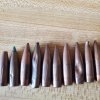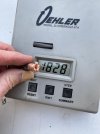Yep, a genius, for sure....And the Bro figured this out 5 posts in! Beautiful!
-
If you are being asked to change your password, and unsure how to do it, follow these instructions. Click here
You are using an out of date browser. It may not display this or other websites correctly.
You should upgrade or use an alternative browser.
You should upgrade or use an alternative browser.
Improving the 308 Win performance
- Thread starter nralifer
- Start date
 Help Support Long Range Hunting Forum
Help Support Long Range Hunting Forum
Got to love the guys that like to **** in peoples Cheerios.
xsn10s
Well-Known Member
- Joined
- Mar 7, 2016
- Messages
- 7,712
Only way to chase off the competition.Got to love the guys that like to **** in peoples Cheerios.
I vote for a 308 Win NI (Nez Improved).
Yep total BS...yet again the caliber changes to a larger case ...cause it's a ridiculous claim.Im pressure he was disputing someone's comment.
Whatever you say captain expert. I disagree with your logic and reread what he wrote in detail. He goes onto explain it later in the post. By the way it's his thread, he's the OP. Chill out!
Who knows maybe it was a 30-378 Bee. I'm sure @nralifer will explain since you're calling him a BSer.
And it's outside the parameters of the discussion of 2000 fps and 1500 ft-lb of energy established for reliable expansion....with the 1770 fps stated it's not valid, and dropped out of contention 200 yds previous...even if it were true.
None of it has anything to do with improving the 308 within the set parameters, which is the discussion. Dreams and BS are not reality. And using a cartridge that holds a 100 to 200 grs of powder, 30" to 40 " plus barrel 30 to 50 lbs as a 2 mile contender, is not a 308 win.
I am a 308 Win fan, own a bunch, with barrels from 16" to 30" long, short action and autos and have improved them with many components and combinations, their of. Chamber my own barrels twist from 12, 11.25, 10, 9, 8,. So I have a pretty fair idea what the cartridge can do. Even with the hybrid 80,000 psi cases. Huge improvements over the 308s of 50 yrs ago. But you only push it so far with what's available...in reality...like any other cartridge. Certain bullets will get the parameters stated at 6 and 700 yards with a 308 Win but will the chosen bullets work with reliable expansion at 2000 fps. I've recovered many bullets at LR, 950 to 1400 yds none expanded , at muzzle velocity of 3000 fps. Squirrels do not usually flop over dead instantly when hit at 950 to 1000 yds mostly squirm around, flopping and kicking for a time, with 308 155 gr bullets, at 3000 fps muzzle velocity..the bullet just punches a 30 caliber hole in the squirrel...birds are more fragile and feathers fly but still a 30 cal hole. Just observations from doing it for a long time with a 308 win. Still all ya need for anything in the lower 48 at reasonable ranges. But I use a 338 win mag with 250 or 275 gr with RL 26 to kill large game inside 100 yds 99% of the time...or my modified 350 Rem Mag 20" light model 7 shooting 250 gr at 2626 fps up close, always inside 100 yds...but a 308 would work too...I just like huge exit wounds.
What a waste of breath and energy. Love the squirrel  comments. That's entertaining!
comments. That's entertaining!
All these bullets have a 3000 fps muzzle velocity. Impacted at 950 and 1000 yds. None expanded.
The first two are Nosler BT one of the most explosive bullets up close but at 950 yds one tip broke off and the plastic tip still intact on the other...known as bullet failure in the hunting community. But they explode inside the 100 to 300 yd range, with a 3000 fps muzzle velocity. Just, The facts, and testing must be done if one is to extend the range of his 308 to see where bullet failure begins,... 450?, 500? And where it's inconsistent. Hunting and sniping are two different endeavors.
The first two are Nosler BT one of the most explosive bullets up close but at 950 yds one tip broke off and the plastic tip still intact on the other...known as bullet failure in the hunting community. But they explode inside the 100 to 300 yd range, with a 3000 fps muzzle velocity. Just, The facts, and testing must be done if one is to extend the range of his 308 to see where bullet failure begins,... 450?, 500? And where it's inconsistent. Hunting and sniping are two different endeavors.
Attachments
Those who can't face reality.. often do not.What a waste of breath and energy. Love the squirrelcomments. That's entertaining!
Give me the load data for the 195 gr bullet used ...I have all the 308 rifles to test it in...even a 300 RUM. What's the data?
I could cheat a bit with the hybrid 80,000 psi 308 cases at my disposal. What load will get me 195 gr at 3250 to 3300 fps? In a 308 Win... or changed to even a, 300PRC or 300 RUM, when it's all fantasy...which is only good for 800 yds to 850 yds inside the parameters, if it expands ...you can not, as it does not exist. The BS isn't helpful, neither is arguing about limiting facts your fantasy disagrees with.
Maybe it was a 50BMG necked to 30 caliber? That might do it? ....
But...How does that fit onto improving a 308 Winchester discussion?
nralifer
Well-Known Member
I called the guy who actually did the load development for the shooter who shot the Elk. I assume you have never used our bullets to hunt with, so your conjectures on how well they expand or their BC do not derive from primary experience. Be that as it may both guys were hunting together, and the load developer, who lives in the area of the Wasatch mountains called the shot for the shooter. They were at about 8900 ft, measured the distance with a laser range finder and the station pressure with a Kestrel. He recalls the station pressure was 21.50, the MV of the developed load was 3007 fps average, temp was between 45-50F. The gun used was a 300WM with a 26" barrel. The photo shows a JBM calculation of the shot. Actually the terminal velocity at impact calculates out to 1881fps (1532 ft-lbs). The bullet hit the Elk in the high Rt shoulder and dropped. The bullet went through and was not able to be recovered. Apparently a Black bear tried to get on the carcass within 5 minutes but they managed to scare it off. Your statement that "high in the mountains would help", minimizes the effect of altitude and atmospheric pressure on bullet resistance. When you run the calculations using either the stated altitude assuming a 1ATM pressure at sea level or the actual station pressure they very very close. The calculator corrects the sea level pressure for the altitude specified. Those are the facts as accurately as I can report them. The fundamental fact was the Elk was killed with one shot at a distance well beyond 1000 yds and at an impact velocity well above we know is needed to expand these bullets.Total ********! ...And that is fact.
Run the ballistics the 195 gr would have to have a muzzle velocity of 3250 fps on and average day to get 1770 fps at 1225 yards. High in the mountains would help but cold weather would make it worse ...but no 308 can reach that velocity, with 195 BD with a given G7 BC of .345 which must be employed after 1000yd to even be accurate information over the G1 BC of .675
I can reach 2856 as a standard load with .360 G7 BC with the 200 gr SMK or max 2950 with hybrid cases and a 30" 8 twist barrel, but even run those at 2910 fps for general work with the powders available and tested so far, and it's definitely not Leverevolution...and that is the best 308 load for bullet velocity and energy down range, and that would get you 700 to 800 yds and still meet the criteria of 1500 ft lbs and 2000 fps. Even the normally available big magnums are hard pressed to meet that criteria at 900 yds, as very few would make 2000 fps the minimum expansion velocity of most bullets. Copper even harder to get to expand if it's designed for high velocity. And the bullet is 1.650" long according to the site they state will stablize in a 10 twist, if it does it will be marginal and not hold its BC for longer shots and becomes unstable. Plus I like the exactly 1225 yds, it's usually not like that ...clue #1. And he's out of parameters with velocity and energy. So I could shoot an elk at 1225 with a 22 LR accidentally hit the brain and it would fall over proclaiming tbe 22 LR a 1200 yd elk cartridge. I like the 308 Win but it ain't magical. We are supposed to be improving it not overstating its general usefulness and current potential.
The second photo is of a 375cal 300 gr SBD2 gel test showing the MV of the shot into the 10% gel which expands at roughly the same speed as the 195 gr 308 cal bullet in question. Sorry, but I don't have a photo of the 195gr 308 cal bullet specifically, but the ogive on the 375 cal bullet is a bit fatter.
Finally, your comment about the 195 being marginally stable is simply not true. Stability increases with decreases in atmospheric pressure, increases in ambient temp and humidity. The third pic calculates the stability under the conditions of the hunt. Unfortunately the fourth photo showing the stability at sea level standard conditions would not download, but the stability factor is 1.379 which is still adequate. The operating principle is that anything that decreases medium density, in this case air density, INCREASES stability. In both cases the bullet is adequately stable. If you think you could kill an Elk at 1225 yds with a single shot from a 22LR, go ahead and try. It would be impressive.
Attachments
Last edited:
nralifer
Well-Known Member
Your data is incomplete. You need to show what the terminal velocity likely was, and that is a function of BC and atmospheric conditions. Also what medium did they impact. Furthermore, the inability of the bullets you show to expand says nothing about our bullets.All these bullets have a 3000 fps muzzle velocity. Impacted at 950 and 1000 yds. None expanded.
The first two are Nosler BT one of the most explosive bullets up close but at 950 yds one tip broke off and the plastic tip still intact on the other...known as bullet failure in the hunting community. But they explode inside the 100 to 300 yd range, with a 3000 fps muzzle velocity. Just, The facts, and testing must be done if one is to extend the range of his 308 to see where bullet failure begins,... 450?, 500? And where it's inconsistent. Hunting and sniping are two different endeavors.
Last edited:
Thank the lord they have an ignore button for ……
I called the guy who actually did the load development for the shooter who shot the Elk. I assume you have never used our bullets to hunt with, so your conjectures on how well they expand or their BC do not derive from primary experience. Be that as it may both guys were hunting together, and the load developer, who lives in the area of the Wasatch mountains called the shot for the shooter. They were at about 8900 ft, measured the distance with a laser range finder and the station pressure with a Kestrel. He recalls the station pressure was 21.50, the MV of the developed load was 3007 fps average, temp was between 45-50F. The gun used was a 300WM with a 26" barrel. The photo shows a JBM calculation of the shot. Actually the terminal velocity at impact calculates out to 1881fps (1532 ft-lbs). The bullet hit the Elk in the high Rt shoulder and dropped. The bullet went through and was not able to be recovered. Apparently a Black bear tried to get on the carcass within 5 minutes but they managed to scare it off. Your statement that "high in the mountains would help", minimizes the effect of altitude and atmospheric pressure on bullet resistance. When you run the calculations using either the stated altitude assuming a 1ATM pressure at sea level or the actual station pressure they very very close. The calculator corrects the sea level pressure for the altitude specified. Those are the facts as accurately as I can report them. The fundamental fact was the Elk was killed with one shot at a distance well beyond 1000 yds and at an impact velocity well above we know is needed to expand these bullets.
The second photo is of a 375cal 300 gr SBD2 gel test showing the MV of the shot into the 10% gel which expands at roughly the same speed as the 195 gr 308 cal bullet in question. Sorry, but I don't have a photo of the 295 gr 308 cal bullet specifically, but the ogive on the 375 cal bullet is a bit fatter.
Finally, your comment about the 195 being marginally stable is simply not true. Stability increases with decreases in atmospheric pressure, increases in ambient temp and humidity. The third pic calculates the stability under the conditions of the hunt. Unfortunately the fourth photo showing the stability at sea level standard conditions would not download, but the stability factor is 1.379 which is still adequate. The operating principle is that anything that decreases medium density, in this case air density, INCREASES stability. In both cases the bullet is adequately stable. If you think you could kill an Elk at 1225 yds with a single shot from a 22LR, go ahead and try. It would be impressive.
So it's not a 308 a winchester as I had suspected. And it still doesn't fit the prameters of discussion with 2000 fps and 1500 ft lbs.I called the guy who actually did the load development for the shooter who shot the Elk. I assume you have never used our bullets to hunt with, so your conjectures on how well they expand or their BC do not derive from primary experience. Be that as it may both guys were hunting together, and the load developer, who lives in the area of the Wasatch mountains called the shot for the shooter. They were at about 8900 ft, measured the distance with a laser range finder and the station pressure with a Kestrel. He recalls the station pressure was 21.50, the MV of the developed load was 3007 fps average, temp was between 45-50F. The gun used was a 300WM with a 26" barrel. The photo shows a JBM calculation of the shot. Actually the terminal velocity at impact calculates out to 1881fps (1532 ft-lbs). The bullet hit the Elk in the high Rt shoulder and dropped. The bullet went through and was not able to be recovered. Apparently a Black bear tried to get on the carcass within 5 minutes but they managed to scare it off. Your statement that "high in the mountains would help", minimizes the effect of altitude and atmospheric pressure on bullet resistance. When you run the calculations using either the stated altitude assuming a 1ATM pressure at sea level or the actual station pressure they very very close. The calculator corrects the sea level pressure for the altitude specified. Those are the facts as accurately as I can report them. The fundamental fact was the Elk was killed with one shot at a distance well beyond 1000 yds and at an impact velocity well above we know is needed to expand these bullets.
The second photo is of a 375cal 300 gr SBD2 gel test showing the MV of the shot into the 10% gel which expands at roughly the same speed as the 195 gr 308 cal bullet in question. Sorry, but I don't have a photo of the 295 gr 308 cal bullet specifically, but the ogive on the 375 cal bullet is a bit fatter.
Finally, your comment about the 195 being marginally stable is simply not true. Stability increases with decreases in atmospheric pressure, increases in ambient temp and humidity. The third pic calculates the stability under the conditions of the hunt. Unfortunately the fourth photo showing the stability at sea level standard conditions would not download, but the stability factor is 1.379 which is still adequate. The operating principle is that anything that decreases medium density, in this case air density, INCREASES stability. In both cases the bullet is adequately stable. If you think you could kill an Elk at 1225 yds with a single shot from a 22LR, go ahead and try. It would be impressive.
Not impressed with the BS of pulling down a ballistics chart to fit a narrative. I like the 8900 ft elevation, but 50° during elk season at 8900 ft is BS, but it doesn't compute at 15 or zero degrees. The other guy always does the computations, maybe even the load development, so the shooter knows nothing. Than Krestrel, and a few other words to try to impress... but it is all BS.
There is no individual confidence with this shooter. What is your rifle and load number? Wind velocity? Wind angle? Average wind velocity?
What is the load data? And what are the S/D?
The bullet did not really expand...so there is that...totally unimpressive try. Sell the BS to someone else.
So what 308 bullets expand consistently well at 308 velocities, say 3000 fps at 900 to 1000 yds? I'll try a few in a couple of barrel lengths, say 22" and 30" you provide load data, to see if it fits the criteria. Except for certain subsonic bullets, at a certain point below 2000 fps most will fail to expand consistently and violently as needed. The barely expanded copper bullet is unimpressive, and doesn't fit full violent expansion needed, just slightly better than no expansion, more like a wadcutter, than a sharp point.Your data is incomplete. You need to show what the terminal velocity likely was, and that is a function of BC and atmospheric conditions. Also what medium did they impact. Furthermore, the inability of the bullets you show to expand says nothing about our bullets.
I wasn't trying to shoot game with them, so I don't care, it's just an observation of target shooting at distance with different bullets. There are different bullets with different BC shot on different days, just laying in the dirt at the impact area.
But you can run the ballistics calculator to find out if ya care to really know, a few 150 gr Nosler BT and 155 Lapua on a few examples a 3000 fps, elevation around 1500 ft, 60/ 85 degrees for an average...but doubt if you do not really care to know.
50 degrees during elk season is quite common at 8900' during September and October bull tags. I'm still trying to imagine shooting squirrels out of trees at 1000 yards. That's truly impressive! Never mind trying to hold a range finder still enough on a squirrel at 1k yards.
Last edited:



